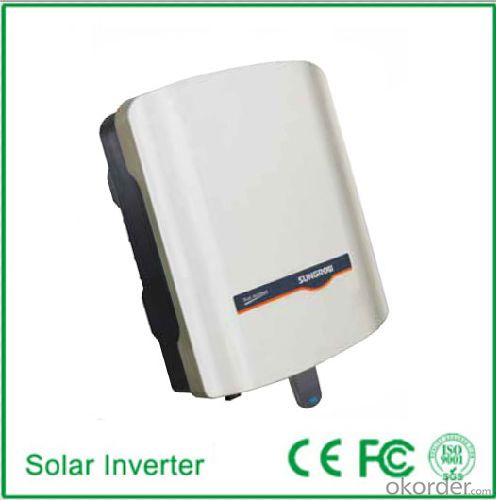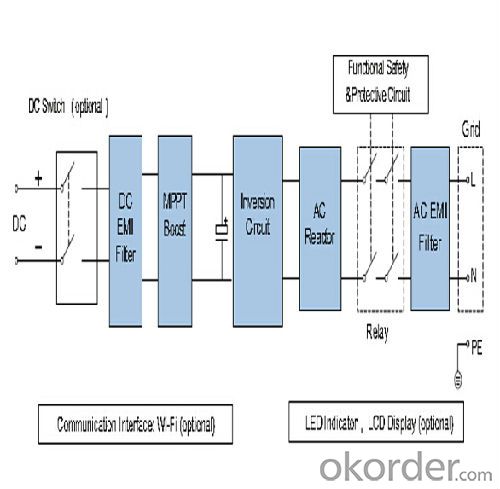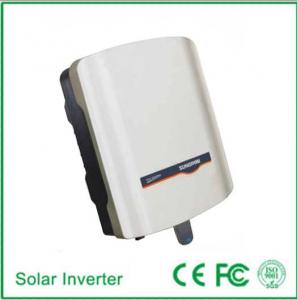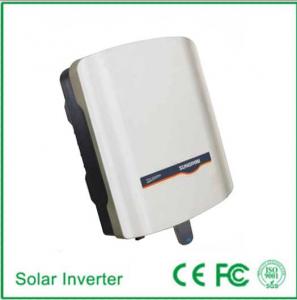Photovoltaic Grid-Connected Inverter SG2K5TL-S
- Loading Port:
- China Main Port
- Payment Terms:
- TT or LC
- Min Order Qty:
- 500000 unit
- Supply Capability:
- 3000000 unit/month
OKorder Service Pledge
OKorder Financial Service
You Might Also Like
1. Structure of Photovoltaic Grid-Connected Inverter SG2K5TL-S Description
A solar inverter, or PV inverter, or Solar converter, converts the variable direct current (DC) output of a photovoltaic (PV) solar panel into
autility frequency alternating current (AC) that can be fed into a commercial electrical grid or used by a local, off-grid electrical network.
It is acritical BOS–component in a photovoltaic system, allowing the use of ordinary AC-powered equipment. Solar inverters have
special functions adapted for use with photovoltaic arrays, including maximum power point tracking and anti-islanding protection.
Suitable for 50Hz/60Hz grid, could be used in Asia, Africa and Europe. Available for hand installation, no need for lifting machinery
assistance.
2. Main Features of the Photovoltaic Grid-Connected Inverter SG2K5TL-S
• Max. input voltage 600V, compatible with different PV panel and string design
• Only 9kg, easy for handling and installation
• Max. Efficiency at 98.0%
• Ultra-quiet, suitable for residential use
• Access to home WiFi system, easy to enjoy the online monitoring
• Wireless communication design, intelligent mobile phone local and remote monitoring
• Product certification: TÜV, CE, AS4777, AS/NZS 3100, VDE AR N 4105
• Manufacturer certification: ISO 9001, ISO 14001, OHSAS 18000
3. Photovoltaic Grid-Connected Inverter SG2K5TL-S Images



4. Photovoltaic Grid-Connected Inverter SG2K5TL-S Specification
Input Side Data |
|
Max. PV input power | 2800W |
Max. PV input voltage | 600V |
Startup voltage | 150V |
Nominal input voltage | 345V |
MPP voltage range | 125~560V |
MPP voltage range for nominal power | 240~520V |
No. of MPPTs | 1 |
Max. number of PV strings per MPPT | 1 |
Max. PV input current | 11A |
Max. current for input connector | 20A |
Output Side Data | |
Nominal AC output power | 2490W |
Max AC output power(PF=1) | 2490W |
Max. AC output apparent power | 2490VA |
Max. AC output current | 11.5A |
Nominal AC voltage | 230Vac (Single phase) |
AC voltage range | 180~276Vac (May vary as per corresponding country’s grid standard) |
Nominal grid frequency | 50Hz/60Hz |
Grid frequency range | 45~55Hz/55~65Hz (May vary as per corresponding country’s grid standard) |
THD | < 3 % (Nominal power) |
DC current injection | <0.5 %In |
Power factor | >0.99@default value at nominal power, (adj. 0.8 overexited~0.8 underexcited) |
Protection |
|
Anti-islanding protection | YES |
LVRT | NO |
DC reverse connection protection | YES |
AC short circuit protection | YES |
Leakage current protection | YES |
DC switch | Optional |
DC fuse | NO |
Overvoltage protection | Varistors |
System Data | |
Max. efficiency | 98.00% |
Max. European efficiency | 97.40% |
Isolation method | Transformerless |
Ingress protection rating | IP65 |
Night power consumption | <1W |
Operating ambient temperature range | -25~60℃ (>45℃ derating) |
Allowable relative humidity range | 0~100% |
Cooling method | Natural cooling |
Max. operating altitude | 4000m (>2000m derating) |
Display | LED, LCD(optional) |
Communication | WiFi (optional) |
DC connection type | MC4 |
AC connection type | Plug and play connector |
Certification | IEC61000-6-2,IEC61000-6-3, |
AS/NZS3100,AS4777.2,AS4777.3 | |
VDE-AR-N-4105, VDE0126-1-1,CE,G83/2,C10/11,EN50438,CGC | |
Mechanical Data | |
Dimensions(W×H×D) | 300*370*125 mm |
Mounting method | Wall bracket |
Weight | 9kg |
5. FAQ of Photovoltaic Grid-Connected Inverter SG2K5TL-S
Q1. What is the difference between inverter and solar inverter?
A1. Inverter only has AC inpput, but solar inverter both connect to AC input and solar panel, it saves more power.
Q2. What is the difference between MPPT&PWM?
A2. MPPT has higher efficiency, it can track the max power point and won't waste energy.
- Q:What is a solar inverter?
- A solar inverter is an electronic device that converts the direct current (DC) electricity generated by solar panels into alternating current (AC) electricity, which is suitable for use in homes, businesses, and the electrical grid.
- Q:Can a solar inverter be used with a backup power supply (UPS)?
- Yes, a solar inverter can be used with a backup power supply (UPS). The solar inverter can convert the DC power produced by solar panels into AC power, while the UPS can provide backup power in case of a utility grid failure. This combination allows for uninterrupted power supply, even during power outages.
- Q:How does a solar inverter affect the voltage stability of a solar system?
- A solar inverter plays a crucial role in maintaining the voltage stability of a solar system. It converts the direct current (DC) produced by solar panels into alternating current (AC) that is used to power household appliances. By constantly monitoring and regulating the voltage, the solar inverter ensures that the electricity generated by the panels remains within the desired voltage range. This helps to maintain a stable and consistent power supply, protecting the solar system from voltage fluctuations and electrical damages.
- Q:What is the maximum output voltage of a solar inverter?
- The maximum output voltage of a solar inverter depends on its design and specifications. Generally, the maximum output voltage can range from 240 to 600 volts for residential inverters, and up to several thousand volts for commercial or utility-scale inverters.
- Q:What is the difference between an on-grid and off-grid solar inverter?
- The main difference between an on-grid and off-grid solar inverter lies in their functionality and purpose. An on-grid solar inverter is designed to convert the direct current (DC) electricity generated by solar panels into alternating current (AC) electricity that can be fed into the electrical grid. This type of inverter is used in grid-tied solar systems, where excess energy can be sold back to the utility company, allowing homeowners to benefit financially. On the other hand, an off-grid solar inverter is used in standalone solar systems that are not connected to the electrical grid. It is responsible for converting the DC electricity produced by solar panels into AC electricity suitable for powering off-grid appliances and storing energy in batteries. Off-grid inverters often include additional features like battery charging and management to ensure reliable power supply in the absence of grid connection. In summary, while both on-grid and off-grid solar inverters convert DC to AC electricity, their purposes differ significantly. On-grid inverters enable homeowners to utilize the grid as a power storage and distribution system, while off-grid inverters are essential for self-sustaining solar systems that operate independently of the grid.
- Q:What are the potential risks of fire or explosions from a faulty solar inverter?
- The potential risks of fire or explosions from a faulty solar inverter include electrical malfunctions, overheating, short circuits, and insulation failures. These issues can lead to the accumulation of heat and energy, causing fires or explosions. Additionally, if the faulty inverter fails to properly regulate the flow of electricity, it can damage connected electrical devices or even cause electrocution hazards. Regular maintenance and inspections are crucial to minimize these risks and ensure safe operation of solar inverters.
- Q:How does a solar inverter contribute to reducing carbon emissions?
- A solar inverter helps reduce carbon emissions by converting the direct current (DC) electricity generated by solar panels into alternating current (AC) electricity that can be used to power homes, businesses, or the electrical grid. By enabling the use of clean and renewable solar energy, solar inverters reduce the need for electricity generated from fossil fuel sources, such as coal or natural gas power plants. This results in a significant reduction in carbon emissions, as solar power is a clean and sustainable alternative to traditional energy sources.
- Q:Can a solar inverter be installed outdoors?
- Yes, a solar inverter can be installed outdoors. However, it is important to ensure that the inverter is specifically designed for outdoor use and is protected from extreme weather conditions such as rain, snow, and excessive heat.
- Q:What certifications should a solar inverter have?
- A solar inverter should have certifications such as UL 1741, IEC 61727, IEC 62109, and IEEE 1547. These certifications ensure that the inverter meets safety, performance, and grid compatibility standards for reliable and efficient operation in solar power systems.
- Q:How does a solar inverter handle shading or partial obstruction of solar panels?
- A solar inverter typically addresses shading or partial obstruction of solar panels by employing a technology called maximum power point tracking (MPPT). This technology allows the solar inverter to constantly monitor the output of each individual solar panel and optimize the power generation by adjusting the voltage and current levels. By doing so, it minimizes the impact of shading or obstruction on the overall system performance, ensuring maximum energy production even in less than ideal conditions.
1. Manufacturer Overview |
|
|---|---|
| Location | |
| Year Established | |
| Annual Output Value | |
| Main Markets | |
| Company Certifications | |
2. Manufacturer Certificates |
|
|---|---|
| a) Certification Name | |
| Range | |
| Reference | |
| Validity Period | |
3. Manufacturer Capability |
|
|---|---|
| a)Trade Capacity | |
| Nearest Port | |
| Export Percentage | |
| No.of Employees in Trade Department | |
| Language Spoken: | |
| b)Factory Information | |
| Factory Size: | |
| No. of Production Lines | |
| Contract Manufacturing | |
| Product Price Range | |
Send your message to us
Photovoltaic Grid-Connected Inverter SG2K5TL-S
- Loading Port:
- China Main Port
- Payment Terms:
- TT or LC
- Min Order Qty:
- 500000 unit
- Supply Capability:
- 3000000 unit/month
OKorder Service Pledge
OKorder Financial Service
Similar products
New products
Hot products
Related keywords






























